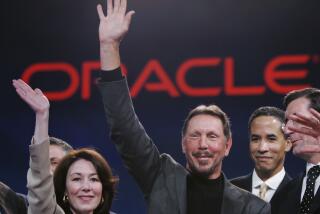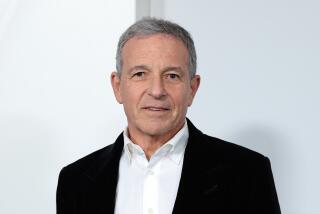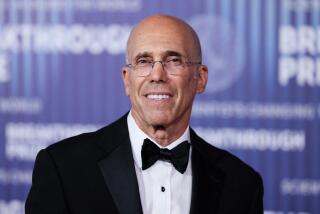Katzenberg Settles Lawsuit Against Disney
One of Hollywoodâs bitterest legal disputes ended Monday when Walt Disney Co. and its former movie chief, Jeffrey Katzenberg, announced that they have settled his $250-million lawsuit against the entertainment giant for a still-undetermined amount.
The deal pulls the plug on the much-anticipated courtroom drama a week before it was scheduled to be tried in Los Angeles Superior Court and comes only after an extraordinary Halloween day meeting between Katzenberg and Disney chief Michael Eisner.
The case had drawn attention because it had brought into public display the personal battle between two Hollywood titans, Katzenberg and Eisner, who worked side by side for 19 years until a falling-out three years ago. Katzenberg has since formed competitor DreamWorks SKG with director Steven Spielberg and entertainment mogul David Geffen.
In his 19-month-old lawsuit, Katzenberg claimed that the company reneged on a promise to give him 2% of the profits of films and TV shows put into production or acquired during his 10-year tenure as Disneyâs top movie executive. That includes such animated hits as âThe Lion King,â âAladdinâ and âBeauty and the Beast,â films that not only reaped profits at the box office but also generated billions of dollars of sales of merchandise, videocassettes, interactive games and other products.
Sources said that the two-step settlement calls for Katzenberg to get a minimum guaranteed amount of money, analogous to an advance against the eventual amount he receives. Neither side disclosed the figure.
The settlement also spells out a second phase in which an arbitration proceeding would determine the overall amount Katzenberg should be paid.
At the core of the settlement, sources say, Disney will pay a percentage of the amount listed by the arbitrator. The percentage was not disclosed, but a source close to Katzenbergâs legal team characterized Disney as getting only a âmodest discountâ on the total.
*
Although the eventual amount Katzenberg will receive is yet to be decided, he is known to have told people that he would not accept less than the much-criticized payout to former Disney President Michael Ovitz, who left Disney last year after 14 months on the job. Ovitz received a package now worth more than $100 million--$38 million in cash and stock options now valued at $85 million.
As part of the settlement both sides also agreed on what films and TV shows would be considered in the arbitration. Also, sources said, some âgray areas,â such as the impact a film like âThe Mighty Ducksâ had on profits relating to Disneyâs professional hockey franchise with the same name, were settled separately for an undisclosed amount.
The agreement comes as lawyers for Katzenberg and Disney, under pressure from two Superior Court judges recruited to push for a settlement, accelerated their negotiations over the past week. Terms were decided on late Friday, with Disneyâs board of directors signing off on the deal Saturday, sources said.
Because the dispute at its heart was a contract disagreement, the settlement is not expected to have widespread business implications in Hollywood. Nonetheless, much was at stake for both sides had the case gone to trial. For Disney, the risk was that it could find itself on the wrong side of a huge financial judgment and have top-secret business practices put under intense public scrutiny, including allegedly damaging memos and notes written by its late president, Frank G. Wells.
In addition, Eisner, 55, probably would have undergone a harsh grilling on the witness stand, and notes from his upcoming autobiography detailing a long-simmering anger toward Katzenberg would have become an issue as well. Katzenbergâs lawyers also would have made issue of the huge payout Disney provided Ovitz.
Katzenbergâs risk was that he would get little, or nothing, after all his legal efforts. Katzenberg, 46, mortaged his home and borrowed money for his $33-million contribution to help start DreamWorks.
Disney would also have tried to embarrass him by challenging his record as a studio executive and dredging up some of the live-action film flops made during his tenure at the studio, such as âCabin Boy.â Some found irony in that Katzenbergâs lawyers would have made an issue out of the fairness of Disneyâs accounting practices when those same practices existed under Katzenberg when he ran the studio.
Katzenberg left Disney in 1994 after a falling-out with Eisner. Katzenberg had lobbied unsuccessfully to succeed Wells as Disney president, a position he felt he had earned.
Since the lawsuit was filed, Katzenberg and Eisner seemed destined for a showdown in court in what had resembled a legal game of chicken, with both sides hurtling unflinchingly toward each other.
Within the past two weeks, both sides became more willing to settle. The Times reported Oct. 31 that people close to the parties were confident that the case would resolve before coming to trial on Nov. 18, and that Eisner had grown more conciliatory.
*
One major step came when Eisner gave his two key negotiators, Disney Senior Executive Vice President Sanford Litvack, a veteran lawyer, and Disneyâs outside attorney, Lou Meisinger, flexibility to try to come up with a settlement. Facing off against them was Katzenbergâs legal team of Hollywood lawyer Bert Fields and veteran New York litigator Herbert M. Wachtell. The two sides met in a series of meetings at the courthouse, the Intercontinental Hotel in Los Angeles and at the offices of Fields and of Meisinger.
That set the stage for a testy, face-to-face meeting on Oct. 31 between Katzenberg and Eisner--the first such meeting in the case--at a downtown Los Angeles hotel that came at the prodding of the two Superior Court judges, Enrique Romero and Owen Lee Kwong, acting as mediators.
No lawyers were present, just Romero and Kwong refereeing what one source described as âa combination meeting and therapy session where many feelings and grievances were aired.â Sources said Katzenberg eventually stormed out, telling Eisner that heâd see him in court. Sources close to Katzenbergâs lawyers say that although the meeting accomplished nothing tangible, it conveyed to Eisner that Katzenberg was willing to fight it out.
Last week, the lawyers began talking again, and by Thursday had come to a tentative agreement, sources said. By dayâs end, however, it had unraveled because Eisner changed his mind.
On Friday, sources said, Eisner began to personally fax Katzenberg notes, explaining why he couldnât agree to a settlement. Disney over the course of the day turned up the heat by serving subpoenas to Katzenberg partners Spielberg and Geffen.
Disney had planned to make DreamWorksâ performance an issue in the trial, arguing that Katzenberg was pushing for money because the fledging studioâs start has been rocky, a source close to Katzenbergâs legal team said. Katzenbergâs lawyers, believing that DreamWorks is irrelevant to the case, had filed a motion asking that information on the new studioâs performance be excluded.
*
Crucial to hammering out the final deal points were Robert Moore, chief financial officer and executive vice president at Walt Disney Studios, and Helene Hahn, a former Disney business affairs executive who now works at DreamWorks. The agreement was reached Friday night.
Even though many Hollywood executives and lawyers had become convinced over the past week that the case would be settled, not everyone involved was confident it would.
âI didnât think it would settle,â said Katzenberg lawyer Fields. âI was wrong. But I think both sides saw the wisdom in settling. While I was looking forward to a trial, from a business and human point of view, itâs better for these two men to get on with their lives.â
Fields said that the case would have cost taxpayers about $1 million had it gone to trial, that both sides have spent millions on the case and that it would have ended up costing âa lot more.â
In a statement, Katzenberg said: âIâm pleased at the outcome and glad Michael and I were able to resolve my business dispute with Disney without having to go to trial. Itâs now time to move on.â
Eisner declined to comment personally, but in a statement Disney said: âWe always prefer to resolve business differences outside of the courtroom and are pleased to have done so with this dispute. We wish Jeffrey well in all of his future endeavors.â
The initial stubbornness of both sides to settle stemmed in part from the personal feud that developed between Eisner and Katzenberg, who had worked together for nearly two decades, first at Paramount Pictures and then at Disney, in what some saw as similar to a complex father-and-son relationship.
Katzenberg often complained privately that Eisner didnât appreciate his contributions. He lobbied unsuccessfully to replace Wells when the then-Disney president was killed in a 1994 helicopter crash in Nevada.
Eisner complained that Katzenberg was taking more than his share of credit for projects, especially Disneyâs animated movies.
Eisner was known to be especially angry with Katzenberg when a front-page Wall Street Journal article on âThe Lion Kingâ in 1994 gave what he believed was disproportionate credit to Katzenberg. He also was furious when Katzenberg leaked his infamous 1991 memo criticizing Hollywoodâs and Disneyâs practice of aiming to make blockbusters with big stars.
More to Read
The biggest entertainment stories
Get our big stories about Hollywood, film, television, music, arts, culture and more right in your inbox as soon as they publish.
You may occasionally receive promotional content from the Los Angeles Times.










